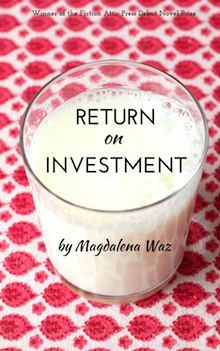Our Research Notes series invites authors to describe their process for a recent book, with “research” defined as broadly as they like. This week, Magdalena Waz writes about Return on Investment from Fiction Attic Press.
+
 Challenge #1 was to use some element of exaggeration to consider a world in which everyone is imbued with the entrepreneurial spirit. That spirit, of course, is partially a derivative of the American Dream and what some people like to call a particularly millennial brand of exceptionalism, but I think it’s safe to drop the millennial altogether.
Challenge #1 was to use some element of exaggeration to consider a world in which everyone is imbued with the entrepreneurial spirit. That spirit, of course, is partially a derivative of the American Dream and what some people like to call a particularly millennial brand of exceptionalism, but I think it’s safe to drop the millennial altogether.
Challenge #2 was to write something longer than the flash fiction I was churning out. A collection of short stories concerning young people in the gig economy felt static. Wouldn’t they all end up learning the same thing? Or even if they each learned something different, their arcs inspected individually felt boring to me.
Challenge #3 was to make sure the resulting novel was not too issue-driven. So I read quite a few issue novels to see how other writers handled it, and the most instructive was Fractures by Lamar Herrin because it dealt with a family deciding where it stood on fracking at a time when its land was up for grabs. It was a deeply-personal story which did not allow the characters’ politics to shape them.
So I had to get personal. It wasn’t jobs and poor prospects for homeownership and savings and stability that really grated on my characters. It was the way these concerns edged out other people and interests.
And then there was Chicago, perpetually bifurcated city. Its streets a grid but the subway system many spokes coming off of a central hub. The city pulls in young people who want to reverse years of isolation in small college towns. So accessible but so hell-bent on ruining itself through a lack of care for the residents who are escaping its confines by the thousands.
I wrote about taking the Red Line and hopping on a bus and seeing the sparkling skyline from nearly everywhere. One of the highest points on the CTA is on the Orange Line as the train pulls out of an industrial stretch past Western Avenue and rises to make a sweeping turn northeast, and framed in the windows is the skyline from behind. The Sears Tower is far more prominent over the tops of residences than it is from the opposite side, surrounded by its compatriots.
I think a lot about electron shell diagrams and concentric circles and how electrons are asked to move on them in these configurations. In Chicago, we don’t have the luxury of resting in those exposed valence shells waiting for one good, strong reaction. We waste energy zigzagging between atoms, following routes not always optimized for our states or eventual plans. I’m finding that to be true in New York (where I live now) as well, and it is also not only the fault of the subway or the grid of streets.
Electrons, they say, have no will. I remember putting those words into the mouth of my high school chemistry teacher. They are not in control of the movements we ascribe to them. They are not privy to a larger plan, but they will perform reactivity when called upon by another force. Their chaos turns into something much more ordered, if only for a second.
Borrowing classifications from Dr. Warren Weaver, Jane Jacobs wrote in The Death and Life of Great American Cities that the city is a problem of organized complexity. Living in one is not chaotic in the sense that it is always unpredictable, but predicting the effect of even a small change on the whole is nearly impossible if you believe the only way to study the elements of a city is in isolation. But there is no isolation in a city. There is only a long string of reactions to systems, people, objects, and more people. And that might be the most compelling and exhausting fact of bumping up against one another and everything else.
+++